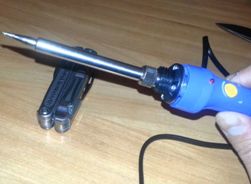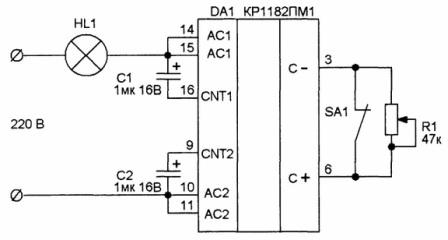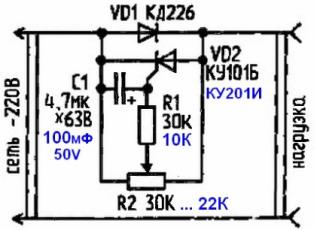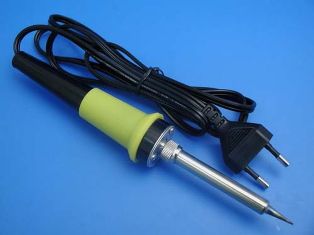Categories: Featured Articles » Practical Electronics
Number of views: 68705
Comments on the article: 4
How to Irradiate a Soldering Iron Tip
 Fireproof soldering iron tips require a delicate attitude. In no case can they be cleaned with files or sandpaper, since the protective layer is quite thin, and its damage will lead to an early burnout and wear of the tip. Such stings can only be periodically wiped on a special sponge (sold with other soldering accessories), or on a wet piece of cloth.
Fireproof soldering iron tips require a delicate attitude. In no case can they be cleaned with files or sandpaper, since the protective layer is quite thin, and its damage will lead to an early burnout and wear of the tip. Such stings can only be periodically wiped on a special sponge (sold with other soldering accessories), or on a wet piece of cloth.
Instead of a special sponge, a dishwashing sponge is quite suitable. Naturally, the sponge should be moistened with water. You can moisten the sponge with glycerin (sold in pharmacies), then the sponge will not dry, always remain wet and ready to work.
To clean a non-combustible tip, among other soldering accessories, special tip cleaners are available. This is such a net, not to say a washcloth, made of brass chips in the shape of a ball, into which the sting should be immersed periodically. In this case, excess solder and oxides remain inside the ball.
To clean the grid, it is enough just to knock on the table, and all the contents fall out. The price of the net is only fifty rubles - not so expensive to buy a few pieces in reserve.
In the process of soldering, one should not “uproot” the conclusions of the parts with a sting, scuff on the board or knock on a jar of solder and rosin. All this can damage the fireproof coating.
The fireproof soldering iron tip layer oxidizes very quickly. Moreover, the higher the temperature, the more intense the oxide is. Therefore, do not overheat soldering iron over 300 degrees. When soldering with POS type solders, the temperature is considered to be 250 ... 300 degrees: the tip does not burn and soldering is pleasant, even comfortable. We will not talk about lead-free soldering here, since in amateur conditions such solders are not used. These are mass production technologies, and ordinary standard solders are quite suitable for repairs.
Approximately estimate whether the soldering iron is not overheated, allows smoke coming from rosin. At normal temperature, a weak stream of smoke rises from a piece of rosin. If the temperature of the soldering iron is too high, touching the rosin resembles a volcanic eruption: rosin sprinkles in different directions with hot drops, smoke does not rise in a thin stream, but in a large cloud flying with the drops. The service sting turns black, and further soldering becomes impossible.
The degree of heating of the tip can also be estimated by the result of soldering. At a normal heating temperature, when the soldering iron manages to melt the solder and heat up the soldering spot, the soldering itself turns out to be shiny with clear external boundaries. Such soldering is usually called contour.
If the soldering iron is not heated to the desired temperature, then the soldering is matte, nostril. The mechanical strength of such a soldering is very low, the details after such a soldering can be pulled out of the circuit with bare hands, especially if the design is made by wall mounting.
An overheated soldering iron heats the solder to such an extent that there can be no question that the solder spreads on the board connecting parts and tracks. Here you can see right away - there is no soldering, or rather no soldering at all.
So, when do we start tinging a soldering iron tip?
So, we assume that the soldering iron is not overheated, what to do next? And then everything is quite simple. It is necessary to take a small shred of cotton fabric, a piece of an old terry towel is ideal, moisten it with water and squeeze it. Squeeze to such an extent that the water does not drip, but the rag would be moist.
In a jar of molten rosin, it always remains after soldering to put a piece of solder in the form of a large drop. Now we must act quickly and accurately.
The sting of a heated soldering iron must be fumbled on a piece of wet cloth. This is done in order to remove oxides from all sides. While the sting did not have time to oxidize again, we dip it in rosin, trying to get under a drop of solder. This finally removes the oxides, the solder begins to melt and sink in rosin. Part of the solder settles on the sting, and we can assume that the sting is tinned and ready to work.
After this procedure, the sting must be wiped with the same cloth as at the beginning. The most important thing in the future is to prevent overheating of the soldering iron over 300 degrees. Otherwise, the sting is oxidized, and all work is in vain.
How to restore a fireproof stinging pad on a video:
How to avoid overheating of the soldering iron
Any soldering iron without a temperature controller can warm up to 400 degrees and above. That's when the rosin begins to hiss and spatter like a volcano. How to avoid overheating?
The easiest way to change the heating temperature with power regulator. Here, the so-called dimmer is quite suitable - a household dimmer that is put in place of a conventional switch.
If you are not too lazy, then the thyristor power controller can be assembled independently, for example, on the chip Kr1182PM2, which allows power control up to 150W. In this case, you do not even need any heatsink to cool the chip.
Read more about the specialized chip Kr1182PM1 in the article "A simple power regulator for smooth switching on of lamps".

Figure 1. Power regulator on the chip Kr1182PM2
Power in the load is regulated by potentiometer R1. When the toggle switch SA1 closes, the load is disconnected. If you install an electrolytic capacitor with a capacity of 47 ... 500 μF parallel to the toggle switch, the load will turn on smoothly. Of course, this is not required for a soldering iron, and when controlling incandescent lamps, the service life of the latter increases.
You can do with a simpler controller, assembled according to the scheme shown in Figure 2.

Figure 2. Simple power control
The positive half-period of the mains voltage passes through the diode VD1 without changes. Only the negative half cycle passing through the VD2 is regulated. Such adjustment is quite enough, because it is completely unnecessary to heat the soldering iron to a power of less than half of the nominal one.
Such power controllers allow you to adjust the heating temperature, while the soldering iron simply lies on a stand. In the process of soldering, the heat from the tip is used to heat up and melt the solder, as well as to heat the place of soldering. Naturally, the tip will cool down, and the faster, the smaller the tip itself and the more soldered parts.
Some soldering irons contain power controllers built into the handle, and yet the temperature controllers used can achieve better results. in soldering stations. Well, if the temperature is set to 250 degrees, so it will hold.
Boris Aladyshkin
See also at e.imadeself.com
:

